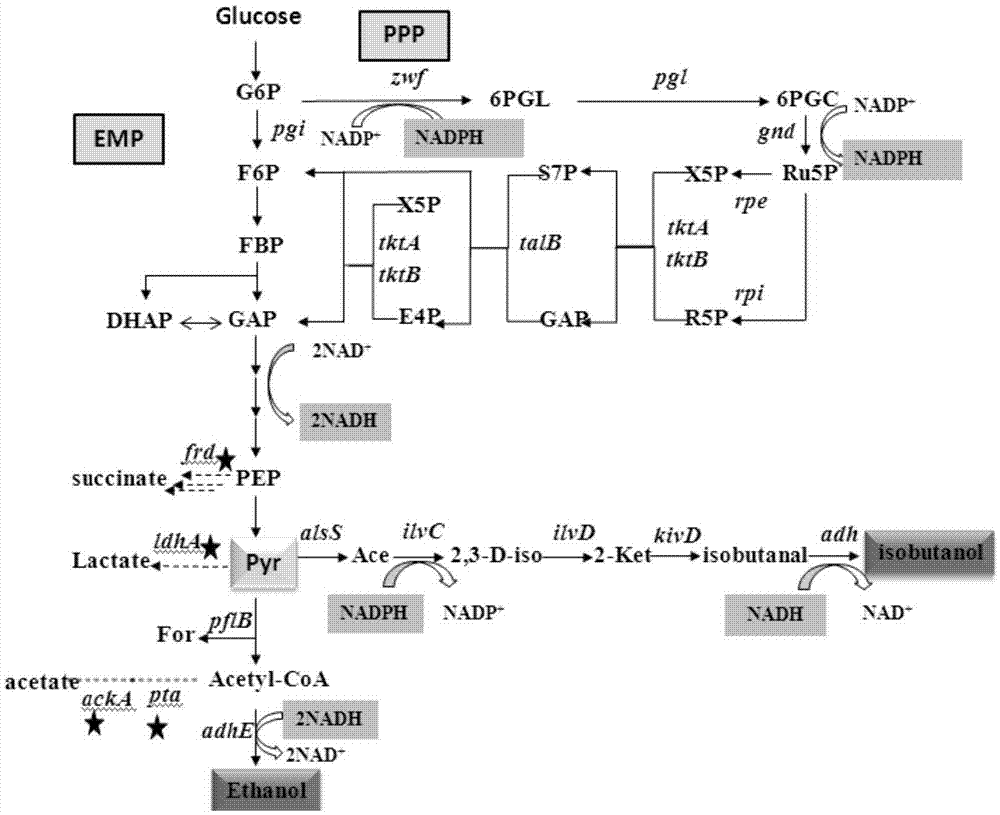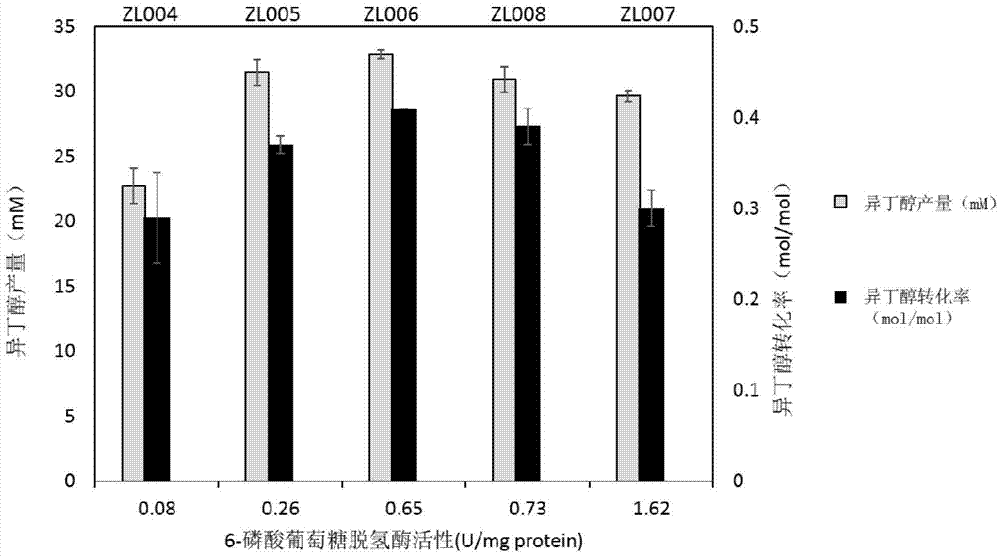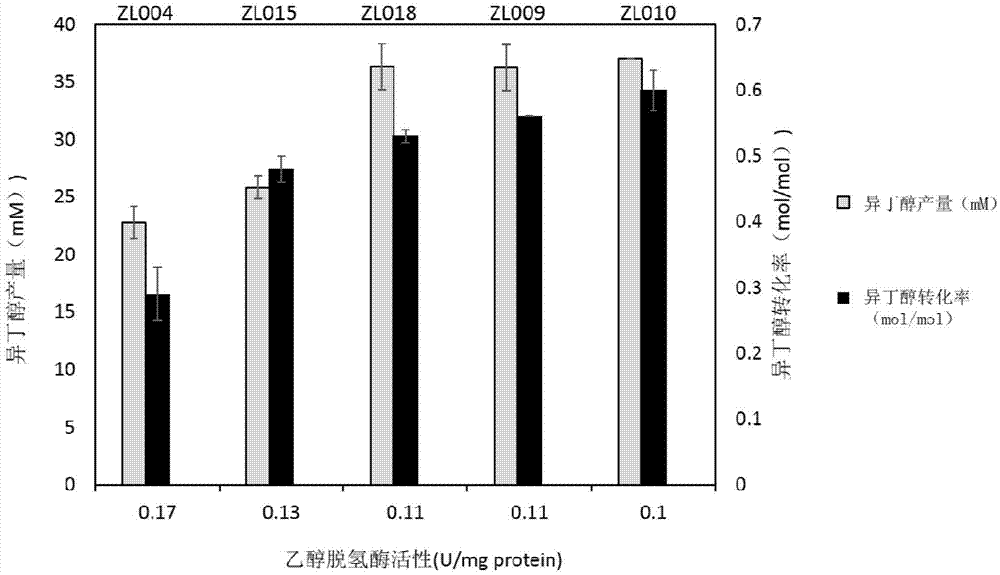Escherichia coli for producing isobutanol and ethanol and preparation method of escherichia coli
A technology of Escherichia coli and isobutanol, applied in the biological field, can solve problems such as imbalance of redox power supply
- Summary
- Abstract
- Description
- Claims
- Application Information
AI Technical Summary
Problems solved by technology
Method used
Image
Examples
Embodiment 1
[0056] Embodiment 1, construction and application of recombinant Escherichia coli ZL004
[0057] 1. Construction of recombinant Escherichia coli ZL002
[0058] 1. Construction of plasmid pXZ021C.
[0059] In the first step, using the pXZ020 plasmid DNA (Shi, et al., Metab Eng, 2013, 16:1-10) as a template, PCR amplification was performed using primers XZ-adhE-1 and XZ-adhE-2 to obtain a long 4662bp DNA fragment, called fragment I;
[0060] The above amplification system is: 10 μl of NewEngland Biolabs Phusion 5X buffer, 1 μl of dNTP (10 mM for each dNTP), 20 ng of DNA template, 2 μl of each primer (10 μM), 0.5 μl of Phusion High-Fidelity DNA polymerase (2.5 U / μl) , 33.5 μl of distilled water, the total volume is 50 μl.
[0061] The above amplification conditions are 98°C pre-denaturation for 2 minutes (1 cycle); 98°C denaturation for 10 seconds, 56°C annealing for 10 seconds, 72°C extension for 30 seconds (30 cycles); 72°C extension for 5 minutes (1 cycle) .
[0062] In t...
Embodiment 2
[0134] Regulation of zwf gene in embodiment 2, recombinant escherichia coli ZL004
[0135] Starting from ZL004, the glucose-6-phosphate dehydrogenase coding gene zwf is regulated through the RBS library, including the following steps:
[0136] 1. Construction of recombinant Escherichia coli ZL004-zwf by homologous recombination for the first time
[0137] (1) Preparation of DNA fragment I for homologous recombination
[0138] Using the pXZ-CS plasmid DNA as a template, a 2722bp DNA fragment I was amplified using primers zwf-cat-sacB-up / down.
[0139] The nucleotide sequence of the DNA fragment I of 2722bp is sequence 5 in the sequence listing, and this fragment comprises about 50bp zwf gene regulatory region upstream homology arm (the 1st-53rd nucleotide of sequence 5), cat-sacB gene fragment (sequence 5 Nucleotides 54-2672), and the initial 50 bp of the zwf gene as a downstream homology arm (nucleotides 2673-2722 in Sequence 5).
[0140] (2) The first homologous recombinat...
Embodiment 3
[0169] Regulation of the adhE gene in embodiment 3, recombinant escherichia coli ZL004
[0170] Starting from ZL004, the alcohol dehydrogenase encoding gene adhE is regulated through the RBS library, including the following steps:
[0171] 1. Construction of recombinant Escherichia coli ZL004-adhE by homologous recombination for the first time
[0172] (1) Preparation of DNA fragment I for homologous recombination
[0173]Using the pXZ-CS plasmid DNA as a template, a 2719bp DNA fragment I was amplified using primers adhE-cat-sacB-up / down.
[0174] The nucleotide sequence of the DNA fragment I of 2719bp is sequence 11 in the sequence listing, and this fragment comprises about 50bp adhE gene regulatory region upstream homology arm (the 1st-50th nucleotide of sequence 11), cat-sacB fragment (sequence 11 Nucleotides 51-2669), the initial 50 bp sequence of the adhE gene is the downstream homology arm (nucleotides 2670-2719 of sequence 11).
[0175] (2) The first homologous recom...
PUM
 Login to View More
Login to View More Abstract
Description
Claims
Application Information
 Login to View More
Login to View More - R&D
- Intellectual Property
- Life Sciences
- Materials
- Tech Scout
- Unparalleled Data Quality
- Higher Quality Content
- 60% Fewer Hallucinations
Browse by: Latest US Patents, China's latest patents, Technical Efficacy Thesaurus, Application Domain, Technology Topic, Popular Technical Reports.
© 2025 PatSnap. All rights reserved.Legal|Privacy policy|Modern Slavery Act Transparency Statement|Sitemap|About US| Contact US: help@patsnap.com



